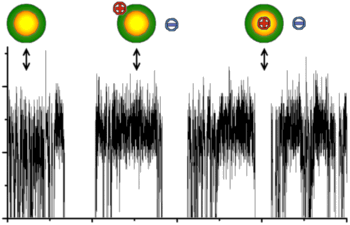Semiconductor nanocrystals are very small particles of semiconductor material, e.g. CdSe, with a diameter of only a few nanometer. Due to their size (comparable to the exciton Bohr radius in the bulk material) the particles can no longer be described by the properties of the bulk. On the contrary; with respect to excitation and emission they behave more like single molecules: The fluorescence of a single molecule under continuous illumination is hardly ever constant in time. It switches on and off randomly, like a telegraph signal. For various combinations of single molecules and their surrounding matrix this blinking is observed and explained. This same behavior has been observed for single nanocrystals, too. However, the reason for their blinking remained unclear.
We have performed measurements on individual (uncapped) CdS nanocrystals at low temperatures (1.5 K). We recorded the luminescence as a function of time to measure the lengths of the “on” and “off” periods. Based on this distribution of lengths and the autocorrelation function we developed a model that could explain the blinking statistics of both uncapped and capped (i.e. with a thin shell of a higher bandgap semiconductor) nanocrystals. The numerical simulations we have performed support our model [1]. We have also derived general analytical expressions to relate the intensity autocorrelation function to the distributions of on- and off-times in the emission of single molecules and nanocrystals [2].
The key features of our simple model are three different possible states of the nanocrystal and a distribution of sites in the matrix that can trap an electron. The first state is the neutral state. Upon excitation an electron-hole pair is created in the nanocrystal. It will recombine under emission of a photon in short time. This state is related to fast blinking and causes short on- and off-times. The other two states can only be populated if, after excitation, the electron tunnels to a trap site in the matrix before recombination takes place. In case the hole stays in the core long off-times can be expected, because a newly created exciton will recombine radiationless. In case of a charged shell, new excitons can be created and can recombine in the core, resulting in long on-times. This state is not available for uncapped nanocrystals.
References
- R. Verberk, A.M. van Oijen, M. Orrit
“Simple model for the power-law blinking of single semiconductor nanocrystals”
Phys. Rev. B 66 (2002) 233202 - “Photon statistics in the fluorescence of single molecules and nanocrystals: Correlation functions versus distributions of on- and off-times”
J. Chem. Phys. 119 (2003) 2214-2222
R. Verberk, M. Orrit



